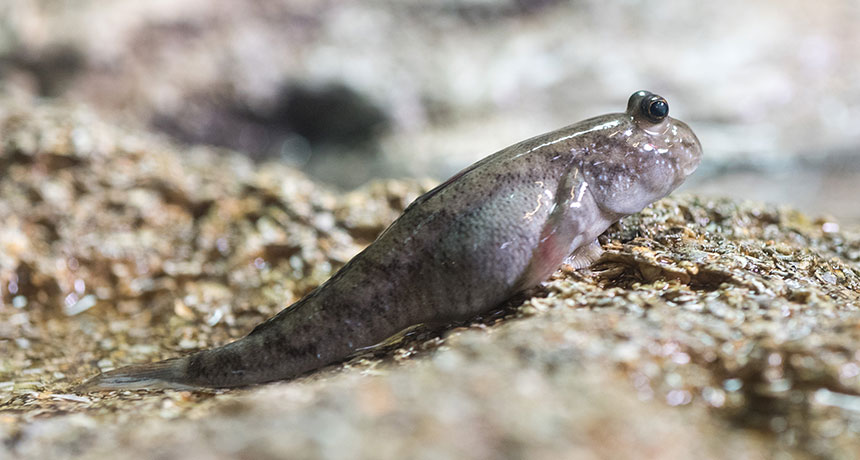Hightailing it out of the water, mudskipper style

Nothing conquers a slippery slope like a good twitch of the tail, say researchers exploring how vertebrates could have taken the first treacherous steps on land.
When early vertebrates invaded land 360 million years or more ago, their tails might have been critical in helping them climb sloping sand or mud, suggests physicist Daniel Goldman of Georgia Tech in Atlanta. These surfaces can suddenly shift from a solid heap to a flowing slide that sends climbers slipping and flailing. Using a tail the right way in a hop-swing kind of gait, however, lets little fish called mudskippers and a dune-invader robot get going on slippery slopes, Goldman and an interdisciplinary team report in the July 8 Science. It’s the latest in research on how animals and robots can cope with treacherous surfaces.
With a well-timed tail push, “you can then get away with pretty crummy limb use and still get propulsion,” Goldman says. A pioneering land vertebrate didn’t “have to be a ballet dancer.”
Studying the function of tails among these early vertebrates hasn’t been simple, partly because of a poor fossil record. Paleontologists have found relatively few complete tail fossils from the transitional creatures, says Stephanie Pierce, curator of vertebrate paleontology at Harvard University’s Museum of Comparative Zoology. She and her colleagues have proposed that an early land invader called Ichthyostega moved right and left forelimbs forward together, similar to how a person on crutches sweeps the supports forward in unison. So “crutching,” as it’s called, may have been a form of tetrapod movement.
Among modern species, little bulging-eyed, big-tailed fish called mudskippers crutch along somewhat like this on their front flippers when venturing onto dry land. Goldman has studied snake and turtle motions on challenging, sometimes solid, sometimes flowing surfaces like sand. His lab joined forces with mudskipper biologists to see how animals with a crutching gait could cope with changeable materials. On flat surfaces, mudskippers hardly ever do anything special with their tails. On sand tilted up 20 degrees, however, the fish added a tail push with almost every other step, the researchers found.
To analyze the contribution of that tail push, Goldman and colleagues sent a two-limbed robot with a movable tail up slopes of plastic particles or poppy seeds. (Sand is dangerous for robot parts.) Positioning the tail to one side and then pushing with it at just the right moment was “critical” on the 20-degree slope, Goldman says. With no tail power, the robot often just dug itself into a hole.
For the research robot, a tail assist “sounds like a very simple maneuver, but to really explain why that works so well on sandy slopes is not trivial,” Goldman says. The interdisciplinary team came up with a way of mathematically analyzing the first step of the climb. “The amount of physics on the second step is much more terrible to contemplate,” he says.
Translating that first step for the robot into tetrapod terms could take some thought. Pierce, for instance, points out that Ichthyostega had two big hind limbs that don’t look useful for powering steps but might have provided stability on challenging ground in some taillike way.
The few sets of preserved footprints from early vertebrates foraying onto or colonizing land don’t show signs of tail drags at all, Goldman acknowledges. However, evolutionary biomechanist John Hutchinson of Royal Veterinary College of the University of London notes that “that’s a very small sample.” If tails are useful mostly on slopes, the signs have slumped away without leaving traces in the fossil record.